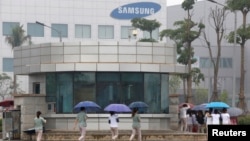From multinational makers of clothing to consumer electronics, companies are reassessing their sources of raw materials, parts and factory assembly because of the pandemic, experts say.
That means countries in Southeast Asia and Latin America are becoming key go-to places in the global supply chain as businesses shift away from China post-pandemic.
China had attracted foreign-invested factories since the 1980s for cheap labor and high productivity. But since the pandemic, China’s traditional role as the world’s factory will be reduced, as American and European multinationals look for parts, labor and assembly at home for higher-end goods — nearby or wherever subsidies are available — according to Jayant Menon, a visiting senior fellow with the ISEAS-Yusof Ishak Institute’s Regional Economic Studies Program in Singapore.
“Countries like China that mismanage COVID will suffer greatly,” Menon told VOA via WhatsApp. “That’s because their zero COVID approach has been very disruptive to supply chains.”
While Southeast Asian countries including Vietnam, Thailand and Indonesia have been lifting pandemic restrictions this year, China reinstated lockdowns in two major cities. The lockdowns upset factory orders — and raised consumer prices — because of shipping slowdowns and worker shortages.
Seeking alternatives to China
In addition to pandemic-related disruptions in China, delays caused by worker shortages at major global ports and airports, including South Korea and the United States, have stifled the flow of consumer goods into Europe, North America and parts of Asia.
Taiwan-based PC developer Acer, for example, is addressing lockdown-driven supply chain problems by qualifying “second sources for materials where needed,” a spokesperson told VOA. The world’s No. 5 PC vendor by market share manufactures largely in China. The second sources will “come from various countries,” the spokesperson said without giving details.
American firms intend to stay in China overall but diversify, said Douglas Barry, communications vice president with the U.S.-China Business Council advocacy group in Washington. “We hear over and over that it’s a mistake to put all your eggs in one basket,” Barry said. “China’s response to COVID and growing geopolitical tensions are reminders of this truism.”
Southeast Asia
Nations such as Vietnam and Thailand were taking business from China before 2020, as investors faced rising Chinese labor costs and higher tariffs thanks to the Sino-U.S. trade dispute that began in 2018.
“I think Southeast Asia will clearly be a beneficiary of all this reconfiguration taking place. Countries like Vietnam, and to a lesser extent Thailand and Malaysia, have already seen gains from restructuring of supply chains,” Menon said.
Vietnam, he said, has a lead because of its workforce talent, pro-business reforms and network of free trade agreements. Electronics giant Samsung and American chip developer Intel both operate in Vietnam, as do foreign-invested car factories.
Malaysia is trying to capture more multinational tech, he noted. Last month, a subsidiary of giant Taiwanese electronics assembler Foxconn Technology signed an agreement with its Malaysian partner Dagang NeXchange to set up a factory, possibly for electric vehicles.
Malaysia, along with Thailand, Indonesia and the Philippines, offer “moderate wages” compared to China, said Rajiv Biswas, Asia-Pacific chief economist with S&P Global Market Intelligence in Singapore.
Multinationals, he said, are likely to expand industrial capacity in multiple places but stay in China for its market of a billion-plus people.
“They will still continue producing in China, but they will create additional production capacity in other hubs, and because of what we’ve seen during the pandemic when you can see disruptions in multiple locations, the resilience in the supply chain comes from having multiple production facilities, which also, I think, includes producing outside of Asia,” Biswas said.
Latin America
In Latin America, especially its industrial hub Mexico, products have been selling to the all-important U.S. market as a border nation. Mexico stands to benefit more from a trend known as near-shoring, analysts say.
A shared border, common time zones and linguistic similarities bring Mexico especially close to the United States, said Evan Ellis, a research professor of Latin American studies at the U.S. Army War College Strategic Studies Institute. The workforce is relatively educated, too, he said.
“Mexico is generally more accessible to many businesses in the United States in terms of the language and the culture and things than, for example, setting up shop in some cases in an Asian country or some other country that’s out of the hemisphere,” Ellis said.
Mexico has attracted American firms since the 1990s and retains “strong advantages,” Ellis said, but drug crimes and electricity costs loom as drawbacks.
Mexico is enticing some investors because its goods can enter the United States duty free under trade agreement rules, communications executive Barry said.
Brazil makes sense for companies that need its natural resources, such as ore or petroleum — or that sell cars for example — to its market of 212 million people, many in middle class cities, Ellis said. He noted that costs and regulations, however, challenge investors in Brazil.
“Manufactures are competing for limited supply of key commodities and logistical capacity, leading to consumers experiencing empty shelves and long purchase lead times,” stated professional services firm KPMG on its website. Now, it adds, “industry is evaluating and investing in their long-term supply chain strategies, paving the way for a new post pandemic normal,” which includes finding alternative customers, markets and suppliers to avoid overdependence on just one.




